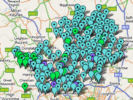|
|
|
Croxley Green Parish created in 1872
from the Parish of
Rickmansworth |
|
|
| |
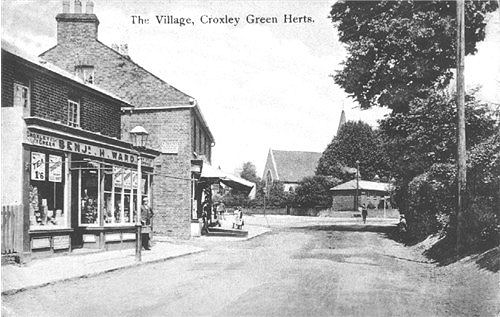 |
| |
The
Village, Croxley Green
Postcard published by B H Ward (the name over the shop)
and
posted in 1906 (Also seen posted 1904)
|
A separate Ecclesiastical District was formed in 1872 at
Croxley Green, and a Church built, dedicated to All Saints, in the Early English pointed transitional style of architecture. The exterior of the edifice is of Bath stone, and the Church consists of chancel, nave, and vestry, with a small round tower, on the north side, containing one bell and a circular spire. On the south side is a handsome porch, approached by a flight of steps. The roof is of timber, and the floor is paved with tiles. Beautifully carved oak stalls are in the chancel, and the Church is provided throughout with solid oak pews. There is a richly embellished reredos of Caen stone, and a stone pulpit. One of the principal features in the building is the splendid east window of stained glass, presented by the Rev. A. H. Barker, Vicar of St. Mary's, Rickmansworth. The total cost of erection of this Church was about £2,500, which was raised by public subscription; it will accommodate 250 people. The living is a consolidated Chapelry, of the value of about £392, in the gift of the Vicar of Rickmansworth. The Primitive Methodists have a neat brick Chapel here, in the New Road, erected in 1868; and there are good Schools. The population of Croxley Green is about 1,000.
The following information comes from the 1953
edition of
The
Buildings of England: Hertfordshire
-
All Saints, 1872, by J. Norton. In
1907 Temple Moore added a new nave to the south of the old (GR). The
difference in quality is remarkable. Temple Moore's design is
original interesting, with lancet windows, and the wall passage carried also
along the straight E end. The arches towards the old building are
roundheaded and rest on short rectangular piers. Exterior of yellow brick
with bands of stone.
-
The characteristic feature of Croxley
Green is its long triangular Green with several pretty buildings, especially
towards the N. End.
-
E. of the N. end of the Green is Little Green Lane one of the new H.C.C. schools
(see Introduction).
-
At the S. end of Croxley Green beyond the
railway Croxley Hall Farm with a splendid late medieval
barn, 101 by 38½ ft, and well preserved inside and out. Nave and aisles,
one entrance transept, kingpost roof, amply strutted. At the Hall some c16 panelling and a brick chimney
remain. The Hall belonged to Dr Caius.
|
Croxley Green Station
Croxley Green station is now - in the 21st century -
merely a shadow of its former busy life. My Auntie Dorrie (Doris Lacey)
worked at this station throughout the Second World War and beyond and told
me many stories of working life on the Watford to Rickmansworth line.
Auntie recalls being at home in Hatch End in 1940 - she would clean the
house on Thursdays. One Thursday she thought she would seek work and went
up to the railway station to ask for vacancies - she chose Hatch End as
this was a proper mainline railway station - not the underground!
She was posted to Croxley Green which was easy and
friendly (in the booking office). She also did relief work at Watford High
Street which led to an offer of permanent work there. She said no. Later
she went to work at Euston but she hated her first job there - two women
and twelve men. She made the tea. She was promoted and refused to make the
tea! She eventually became a clerk in the British Railways personnel
office.
Her memories of the ticket office at Croxley Green are
vivid. The watercress growers of the Chess Valley would bring their
baskets to the station to be sent to the markets in London. She got on
well with these regular station visitors and they gave her some of their
used baskets which she lined with old fabric to make my first carry cot
when I was born in 1945! On Watford market days the young mothers of
Croxley would catch the train to Watford High Street station but they
would leave their prams in the left luggage office for which they had to
pay a penny. Auntie felt so sorry for them that on the days the station
master was not on duty she would let them leave their prams in the ticket
office for nothing and keep an eye on them herself. The station master
never found out! Her morning shift began very early before the first train
of the day. She would set off from home in Hatch End shortly after 4 am
and pedal along Oxhey Lane past Carpenders Park and Bushey Arches. She
bought the bike from my mother for £5 after Mum joined the WRAF and was
posted to Egypt. Auntie remembers a policeman would regularly see her on
these early morning rides and pedal alongside her to keep her safe! All
her memories of Croxley during the war years are full of happy anecdotes
of warm-hearted and caring local people.
Information provided by John Howard
Norfolk (jhnorfolk @t
googlemail.com), May 2008 |
Book: Rickmansworth, Chorleywood &
Croxley Green - A collection of photographs
Book:
Croxley Green as it used to be - A collection of Photographs
There are a number of web sites which could be
of interest. There is a very interesting history An
Outline History of Croxley Green (130 BC to 1934 AD) reproduced form an
old typescript whose author is currently unknown. The text can be found on CroxleyGreen.com.
The Friends of the
Green site at www.themcgregors.demon.co.uk/fotg/
(not found Nov 2006) includes a map showing the listed buildings. All Saint's
Church also has a web site croxleygreenallsaints.org
which includes some pictures, a description of the main features of the
building, and a useful history. The Methodist church also has a web
site, with a picture and short history.
|
The history of an ancient barn
(which is looking for friends to ensure its future survival) is
described
online. There are also some
excellent photographs including the following:
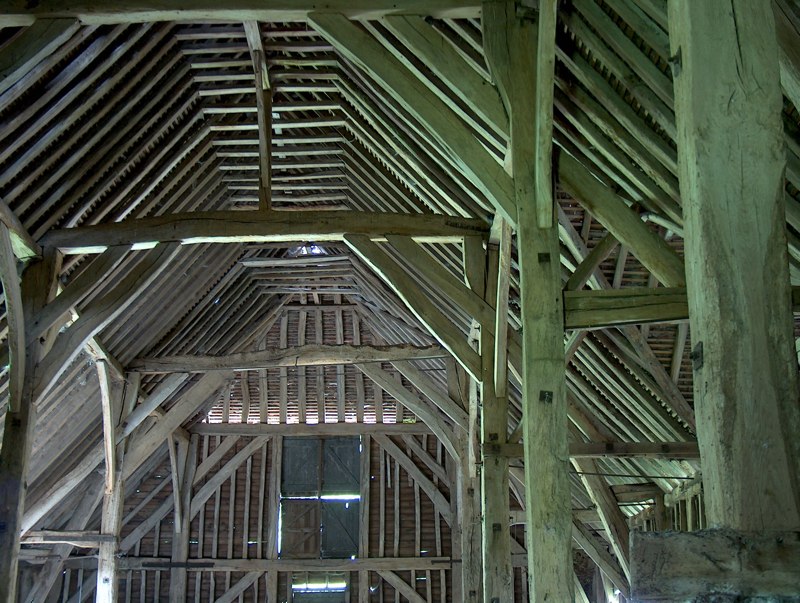 |
|
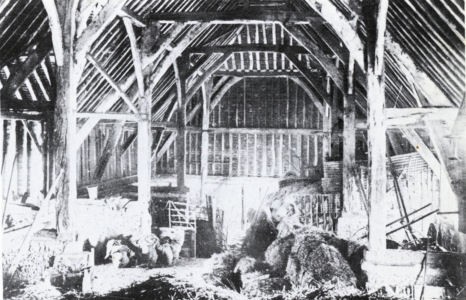 |
|
This picture of 1912
shows the vast interior of the barn and its timber
structure, some 35 feet from floor to ridge. There has
been some argument as to whether the roof beams may be
of oak or chestnut. The roof caved in and the building
was in a bad condition during the 1960's, but it has now
been restored to its former appearance.
Rickmansworth - A Glimpse of the Past |
|
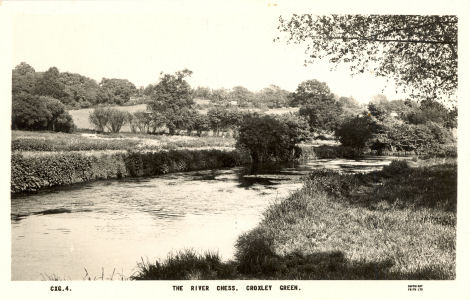 |
|
The River Chess
Croxley Green
A
Frith
Post Card |
f you can add to the information given
above tell me.
Page updated January 2012

